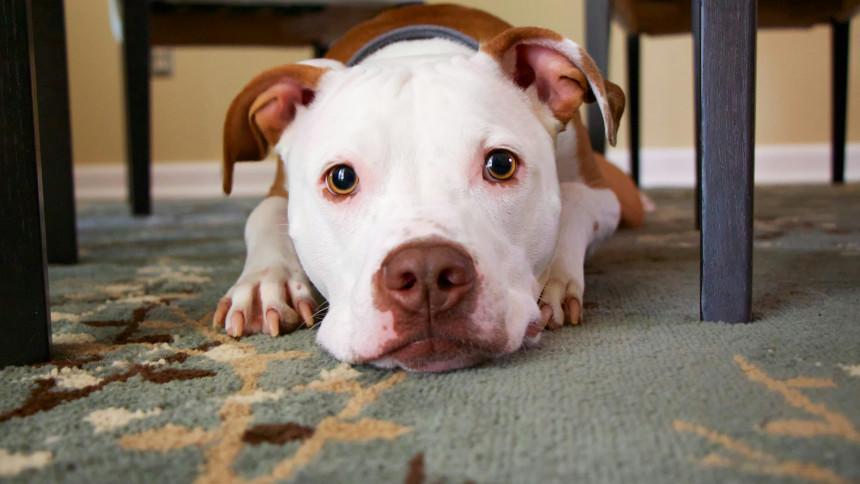Dog zoomies, scientifically known as Frenetic Random Activity Periods (FRAPs), are bursts of energetic play that dogs of all ages exhibit, often resulting in frenzied sprints around the house or yard. While zoomies can happen at any time, they frequently occur at night when dogs have pent-up energy to release. Witnessing your dog race around with abandon might seem chaotic, but these outbursts are a normal part of canine behavior.
The occurrence of zoomies at night tends to be a cathartic release for dogs, allowing them to burn off excess energy from the day. This behavior may be more pronounced if a dog has had limited physical activity or mental stimulation throughout the day. As the day winds down and the household becomes quieter, dogs might take this as an opportunity to engage in this spirited activity before settling down for sleep.
Understanding and managing zoomies is important for pet owners, as it not only prevents potential accidents during these intense flurry of movements but also because it provides insight into a dog’s needs for exercise and mental engagement. Factoring in regular playtimes, walks, and training can help mitigate the sudden surges of nighttime energy. While a typical and healthy behavior, if zoomies are causing concern or occurring excessively, consulting with a veterinarian or professional dog trainer could provide tailored strategies to ensure a balanced routine for your pet.
Understanding Dog Zoomies
Dog zoomies, a common canine behavior, reflect in bursts of energy where dogs will run in circles or erratic patterns, often seen during nighttime.
Defining Zoomies and Frenetic Random Activity Periods
Zoomies, or Frenetic Random Activity Periods (FRAPs), are sudden, spontaneous energy bursts observed in dogs. During a zoomie, a dog may exhibit the following behaviors:
- Running in circles: Dogs may sprint around the house or yard in no particular pattern.
- Spinning: Some dogs spin in place or chase their tails.
These periods are characterized by repeated and frenetic behaviors. Canine behaviorists note that FRAPs are a normal part of dog behavior, serving as an outlet for pent-up energy. Younger dogs and certain breeds may be more prone to experience these energetic episodes. Zoomies are often triggered by situations such as:
- Noise or excitement
- After bath time
- Lack of exercise during the day
- Release from confinement (like a kennel or being inside all day)
The triggers for zoomies can be personalized to each dog; owners typically learn to anticipate when their dog is likely to exhibit this behavior. While often humorous and seemingly erratic, zoomies are a natural expression of canine exuberance and should not be a cause for concern unless they result in unsafe situations for the dog or its environment.
Causes of Nighttime Zoomies
Nighttime zoomies in dogs, also referred to as Frenetic Random Activity Periods (FRAPs), can often be attributed to two main factors: unspent energy and stress, and various physical and emotional triggers. Understanding these causes can help dog owners manage and anticipate their pet’s bursts of energy.
Unspent Energy and Stress
Dogs may exhibit nighttime zoomies as a result of unspent energy accumulated throughout the day. This is especially prevalent in young dogs who have a natural abundance of energy and may not have had sufficient physical activity to tire them out. Late evening bursts of energy can be their way of expelling this pent-up energy before settling down for the night.
- Pent-up Energy: Dogs, particularly young or active breeds, require ample exercise. Without it, their surplus energy manifests as zoomies.
- Stress: Canine stress or anxiety can trigger nighttime zoomies. Dogs might use these bursts of activity as a coping mechanism to alleviate tension.
Physical and Emotional Triggers
The occurrence of zoomies can also stem from specific physical and emotional triggers, which might vary from one dog to another.
- Stressful Situations: Events that induce stress or excitement, such as baths or prolonged confinement, can lead to a release of energy through zoomies.
- Emotional Response: Dogs may react to anxiety, fear, or general excitement by displaying a frantic bout of activity, often seen as joyful or playful behavior.
By considering the reasons behind nocturnal zoomies, owners can better address their dog’s needs, ensuring they receive adequate exercise and maintain a stress-free environment to minimize these energetic episodes.
Zoomies Across Different Dog Ages
Zoomies, the spontaneous bursts of energy causing dogs to run in circles or sprint around, can manifest differently across various ages, with younger dogs frequently displaying more intense activity due to their higher energy levels.
Puppies and Younger Dogs
Puppies and younger dogs often experience zoomies as an output for their abundant energy. They are in the developmental stages where playfulness and curiosity are at their peak. These dogs typically have a higher energy reserve and require more physical activity to remain mentally and physically healthy. Exercise is especially crucial for them as it aids in the growth and development process.
Senior Dogs
Senior dogs exhibit zoomies less frequently as their energy levels naturally decline with age. However, they can still have moments of heightened activity where they express this behavior. It’s a positive sign indicating they have maintained some of their youthful vitality. For senior dogs, zoomies could also be a way to alleviate stiffness, encouraging circulation and joint movement, albeit their sessions might be shorter and less vigorous compared to their younger counterparts.
Preventing and Managing Night Zoomies

Night zoomies in dogs can disrupt both the pet and the owner’s routine. Preventative measures primarily involve consistent physical exercise and mental stimulation through training to ensure a peaceful night.
Routine Physical Exercise
Regular physical exercise is crucial for dogs to expend their energy and reduce the occurrence of night zoomies.
- Daily walks:
- Morning and evening walks help maintain a consistent exercise schedule.
- Incorporating running or playing fetch adds variety and increases the intensity of workouts.
- Adequate playtime:
- Interactive play sessions during the day help lessen pent-up energy by nightfall.
- Safe, controlled environments where dogs can run freely, such as fenced yards, are ideal.
Mental Stimulation and Training
Mental engagement is equally important as physical activity for preventing excess energy that leads to night zoomies.
- Training sessions:
- Regular, short training sessions challenge dogs’ minds and improve obedience, which can be useful to manage abrupt bursts of energy.
- Incorporating commands such as “sit” or “stay” can effectively redirect a dog in mid-zoomie to a calmer state.
- Engaging activities:
- Puzzle toys and scent games provide an outlet for mental exploration.
- Such activities encourage focus, which can be particularly tiring, leading to a more restful night.
By providing dogs with a balanced regimen of physical exercise and mental stimulation, a pet owner can significantly reduce the likelihood of disruptive nocturnal zoomies.
Safety During Zoomies

When a dog experiences zoomies, typically characterized by running in circles and spinning, it’s essential to maintain their safety. A safe environment allows them to express this burst of energy without risk of injury.
Creating a Safe Environment
- Remove Obstacles: Clear the area of any furniture or objects that could pose a risk. This minimizes the chances of a dog colliding with potential hazards during a spontaneous burst of energy.
- Floor Traction: Ensure that floors provide adequate traction to prevent slipping. Rugs or mats can offer grip for dogs, especially when they’re running or spinning in circles.
- Crate Considerations: If a dog is crated, zoomies should be monitored to prevent injury. Crates should be spacious enough and bedding secure to allow for movement without harm.
- Secure Outdoor Areas: If a dog has access to an outdoor area for their zoomies, ensure it’s safely enclosed and free from dangerous items or toxic plants.
When to Seek Professional Help

Zoomies in dogs are typically harmless bursts of energy, but in some cases, they can signal underlying issues that require professional attention. Owners should be vigilant and discern when behavior is abnormal and warrants intervention from a veterinarian, dog trainer, or a veterinary behaviorist.
Identifying Abnormal Behaviors
- Frequency and Intensity: If the zoomies are happening multiple times a day or with intense vigor, surpassing typical puppy energy levels, this could indicate a deeper issue.
- Context of Occurrences: Zoomies following a bath or during playtime might be normal, but if they occur without an apparent trigger or after every stressful event, it may be a sign of anxiety.
- Physical Symptoms: Should a dog display any signs of pain during or after the zoomies, such as limping or whining, this can be a red flag for conditions like arthritis or other physical ailments.
- Behavioral Changes: Sudden behavioral changes coinciding with episodes of frenetic activity, like increased aggression or fearfulness, are noteworthy.
- Response to Commands: Persistent disregard for commands or inability to calm down after a zoomie episode may reflect a need for professional training.
| Sign | Potential Indication | Recommended Action |
|---|---|---|
| Excessive Zoomies | High energy or anxiety | Consult a dog trainer |
| Pain Signs | Medical condition such as arthritis | Visit a veterinarian |
| Behavioral Shifts | Anxiety or stress | See a veterinary behaviorist |
| Ignoring Commands | Lack of training or high stress | Professional dog trainer assessment |
In such circumstances, seeking the expertise of a veterinarian is crucial. They can rule out or diagnose any medical conditions. If the issue is more behavioral, a skilled dog trainer or veterinary behaviorist can offer tailored solutions to manage the dog’s night-time energy outbursts effectively. They will consider the dog’s entire health and behavior history to suggest appropriate management strategies or treatment plans.
Dog Zoomies and Health
Dog zoomies at night may reflect underlying health aspects relating to physical conditions or the impact of diet and exercise on a dog’s well-being.
Physical Conditions and Dog Zoomies
Some dogs experience bursts of energy at night, known as zoomies, that can be linked to their physical health. If a dog expresses an excessive amount of zoomies, it may be a signal for an owner to seek veterinary help to rule out any possible underlying conditions. For example, a sudden increase in zoomies post-bath could indicate skin discomfort or allergies, while an overall increase in nightly activities might signal restlessness due to a lack of physical stimulation during the day.
The Role of Diet and Exercise
A dog’s diet can directly impact their energy levels. Feeding a dog high-value treats or foods with high caloric content late in the day can lead to increased nighttime energy, translating into zoomies. On the other hand, adequate and appropriate diet coupled with sufficient exercise is crucial in managing a dog’s energy. Dogs need enough physical stimulation during the day to release pent-up energy. Inadequate exercise can result in a surplus of energy, often released in a burst of activity during the less active nighttime hours.
Cultural and Behavioral Aspects of Zoomies
Zoomies in dogs, often referred to as Frenetic Random Activity Periods (FRAPs), tap into the primal instincts of canines and vary across breeds, displaying unique running patterns and behaviors.
Instinctual Behaviors and Breed Characteristics
Dogs, regardless of breed, may express zoomies as an outlet for primal instinct—a form of repetitive behavior aimed at releasing pent-up energy. This can often be seen in the evening, when a dog may have accumulated energy from a day with less activity. A play bow often precedes the zoomie, signaling a desire to engage in play and run.
Certain breeds, especially those historically bred for high-energy work, such as herding or hunting, are more prone to exhibit zoomies due to their innate drive for movement. For example, collies or retrievers may demonstrate more frequent and intense zoomies than lower-energy breeds.
The act of running in zoomies serves multiple functions. It’s a form of exercise, a stress reliever, and sometimes even akin to the irritation-driven movements like flea bites, even though it’s not related to actual fleas. Zoomies can mirror these sudden, quick motions as dogs engage in rapid, sometimes circular, running—especially during nighttime when the environment is calm, and their behavior does not compete with daytime distractions.
Through understanding the cultural and behavioral aspects of zoomies, pet owners can provide their dogs with proper outlets for these instinctual bursts of energy, such as ample playtime or evening walks, which can help in managing this ingrained conduct.
Aftercare and Relaxation Post-Zoomies
Following a bout of zoomies, it’s important to help dogs transition to a calm state. This aids in preventing stiffness and ensuring they rest well after expending a burst of energy.
Warm-Up and Cool-Down Routines
Implementing warm-up and cool-down routines can be beneficial for a dog’s post-zoomie relaxation. After the sudden high-energy activity, a cool-down routine helps a dog’s muscles relax and recover, reducing the possibility of any stiffness. Similarly, if a dog engages in zoomies after an extended period of rest or immediately after waking from sleep, a warm-up routine could prepare their muscles for the activity and may prevent injury.
Cool-Down Routine:
- Engage in a short walk: A gentle walk encourages a gradual decrease in heart rate and allows muscles to relax.
- Massage: Gentle pet-specific massage can help muscles to relax and provides a moment of bonding and calming interaction.
- Calm Environment: Ensuring the dog returns to a quiet, comfortable environment helps them settle down.
Warm-Up Routine (if applicable):
- Encourage gentle play: Before an expected zoomie session, light play can serve as a warm-up to get the muscles moving.
- Stretching Exercises: Controlled stretching exercises, like coaxing the dog to reach for a treat between their paws, can warm up muscles. Only pursue this if the dog is happy and receptive.
- Consistency: Regular, daily routines both day and night, including consistent bath times or play sessions, can help a dog anticipate and prepare for zoomies, reducing the risk of injury during sudden spurts of activity.








